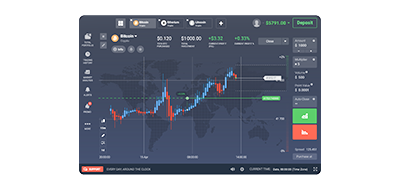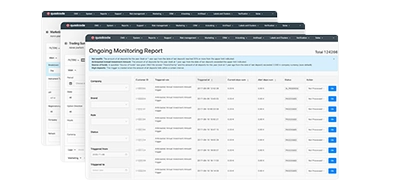Volver
Contents
¿Qué es una orden de stop?

Iva Kalatozishvili
Business Development Manager

Demetris Makrides
Senior Business Development Manager
Las órdenes stop, también conocidas como órdenes stop loss, son instrucciones de trading para que su bróker compre o venda un activo una vez que alcance un precio específico. Esta orden está diseñada para ayudarle a proteger sus ganancias o mitigar pérdidas en caso de fluctuaciones del mercado en su contra, iniciando automáticamente una operación sin que tenga que estar pendiente del mercado constantemente. Una vez que se alcanza el precio stop en una operación, la orden stop se convierte en una orden de mercado. Se ejecuta con prontitud al mejor precio disponible.
Entendiendo cómo funcionan las órdenes de stop
Las órdenes stop se consideran una herramienta vital para gestionar los riesgos relacionados con las actividades de trading. Al establecer una orden stop, se especifica el nivel de precio al que se desea vender o comprar el activo y salir del mercado si la tendencia se vuelve desfavorable.
Una vez alcanzado el precio límite, una orden de stop loss se transforma en una orden de mercado, pero no garantiza un precio de ejecución determinado. Como alternativa, puede usar una orden de stop loss limitada para restringir la ejecución de la orden al precio límite o a uno mejor; sin embargo, si el precio de la acción se aleja rápidamente del nivel deseado, la orden podría no completarse.
Beneficios de las órdenes de stop
Implementar órdenes stop puede ofrecer ventajas a operadores e inversores en términos de gestión de riesgos y automatización de posiciones de trading en diferentes marcos temporales, como el day trading o la inversión a largo plazo. Una ventaja clave es la posibilidad de protegerse de pérdidas sin necesidad de supervisar constantemente los gráficos. Con la ejecución automática, los operadores pueden mantener sus carteras protegidas y gestionar sus riesgos sin tener que estar pendientes constantemente del mercado ni de los gráficos.
Otra ventaja de las órdenes stop es que te ayudan a protegerte eficazmente al asegurar ganancias cuando el valor de tus activos aumenta desde la apertura de la operación. En situaciones donde el mercado está en tendencia alcista y deseas mantener tu posición abierta y seguir la tendencia alcista, protegiéndote de posibles caídas o reversiones, usar una orden stop es ideal. Por ejemplo, puedes hacerlo estableciendo una orden stop. A medida que el precio del mercado sube, puedes modificar el precio stop en consecuencia para asegurar ganancias y, al mismo tiempo, proteger tus fondos en caso de un cambio repentino.
Las órdenes stop ofrecen ventajas psicológicas al eliminar el componente emocional de las decisiones de trading, algo que a muchos traders e inversores les resulta difícil tomar por su cuenta, especialmente al decidir vender un activo ante la preocupación de perder oportunidades o la inquietud de sufrir pérdidas prematuramente. Implementar una orden stop elimina estos factores al implementar un plan de salida preestablecido que promueve un enfoque más estructurado y lógico para las decisiones de trading, en lugar de actuar según las emociones, especialmente al comenzar con una pérdida no realizada. Las órdenes stop loss son una forma sencilla de añadir más disciplina a una estrategia de trading.
Además, las órdenes stop ofrecen una ventaja a los inversores que no pueden estar siempre atentos a los gráficos ni monitorizar sus inversiones por diversas razones, como limitaciones de tiempo u otras obligaciones que los mantienen ocupados e impiden la gestión activa de sus posiciones en todo momento. Las órdenes stop ofrecen una solución al automatizar el proceso de ejecución, permitiendo que las operaciones se ejecuten según lo previsto sin necesidad de supervisión continua. Esta característica convierte a las órdenes stop en una herramienta valiosa, ideal tanto para operadores activos como para aquellos con objetivos de inversión a largo plazo.
Desventajas de las órdenes de stop
Si bien las órdenes stop ofrecen beneficios a operadores e inversores, no deben pasarse por alto sus posibles desventajas. Es crucial evaluar cuidadosamente los riesgos que conllevan. Una preocupación importante es el deslizamiento de precios que puede ocurrir cuando se activa una orden stop. En cuanto esto ocurre, la orden se transforma en una orden de mercado y se ejecuta al precio vigente. En mercados con baja liquidez, esto podría llevar a que la orden se complete a un precio muy diferente del precio stop, lo que se conoce como deslizamiento. Esta situación podría resultar en la compra o venta a un precio no tan favorable como se esperaba al establecer una orden stop, lo que podría reducir las ganancias o aumentar las pérdidas.
Otra desventaja es la posibilidad de que las órdenes stop se activen por cambios de precio de corta duración que no reflejan con precisión la dirección del mercado a largo plazo. Los mercados financieros pueden ser bastante impredecibles en ocasiones, especialmente en el caso de las criptomonedas, y los precios pueden subir o bajar brevemente sin indicar un cambio en la tendencia del mercado. Establecer una orden stop demasiado cerca de la acción del precio puede provocar que se active por estos movimientos temporales, cerrando posiciones inesperadamente. Lo que suele empeorar las cosas en este escenario, donde se vende un activo por menos de lo esperado, es ver que el activo reanuda su movimiento favorable tras un rebote, pero se pierden todas las ganancias y, en cambio, se asume una pérdida debido a una orden stop.
Además, los mercados con baja liquidez presentan desafíos con las ejecuciones parciales. Esto ocurre cuando las órdenes stop se activan al precio stop, pero solo se ejecutan parcialmente debido a la insuficiente presencia de compradores o vendedores para completar la orden completa. Esto resulta en que solo una fracción de la orden se ejecuta al precio previsto, especificado y deseado, mientras que el resto se ejecuta a tasas menos favorables o no se completa. Esta transacción incompleta podría complicar las estrategias y planes de trading para el inversor, ya que podría generar una posición que requiera gestión.
Además, si bien las órdenes stop pueden automatizar las operaciones y eliminar la influencia emocional en la toma de decisiones, también pueden generar una falsa sensación de seguridad. Los operadores podrían confiar demasiado en las órdenes stop, creyéndolas completamente seguras, sin considerar los posibles riesgos de deslizamiento, ejecuciones parciales, errores humanos al colocarlas o las circunstancias del mercado que podrían afectar la ejecución de las órdenes. Es fundamental reconocer que las órdenes stop sirven como una herramienta, más que como una medida de seguridad, y deben utilizarse junto con un plan integral de gestión de riesgos.
En algunos casos, en mercados muy influenciados o con bajo volumen de negociación, las órdenes stop podrían no ser eficaces debido a la manipulación de los precios para activarlas intencionalmente. Esta estrategia, llamada "stop hunting", consiste en impulsar el precio a niveles donde se posicionan numerosas órdenes stop, lo que genera una cadena de ejecuciones que podría impulsar el precio en una dirección indeseable. Mediante mapas de calor, es posible ver dónde se acumulan las órdenes stop y, a continuación, impulsar el precio a esos niveles para activarlas y liquidar a los operadores. En estos casos, los operadores podrían verse obligados a abandonar sus posiciones con stop, solo para ver cómo el mercado rebota a su favor tras ejecutarse la orden stop.
Consejos prácticos para el uso de órdenes de stop
Al utilizar órdenes de stop de manera efectiva, es importante ubicar el precio de stop ni muy cerca ni muy lejos del precio de mercado actual para evitar que se active por cambios normales del mercado o enfrentar pérdidas mayores a las previstas debido a la volatilidad de los activos y consideraciones de tolerancia al riesgo.
Integrar órdenes stop con otras técnicas de trading también puede aumentar su eficiencia. Por ejemplo, incorporar una orden stop dinámico modifica automáticamente el precio stop a medida que el precio del mercado se inclina a favor de la orden. Esto puede ayudar a asegurar ganancias y, al mismo tiempo, a protegerse contra posibles pérdidas.
También es crucial reevaluar y modificar sus órdenes stop según la evolución de las tendencias del mercado y su enfoque de inversión. Los mercados están en constante evolución; una orden stop que antes tenía sentido podría dejar de ajustarse a las condiciones del mercado o a sus objetivos de inversión a medida que evolucionan.
Conclusión
Usar una orden stop es un recurso valioso para los operadores, ya que ayuda a gestionar los riesgos y proteger las ganancias al ejecutar operaciones automáticamente cuando el mercado se desvía de una posición. Al comprender completamente el funcionamiento de las órdenes stop y conocer sus ventajas y desventajas, así como las técnicas de aplicación, los operadores e inversores pueden mejorar sus tácticas de trading y tomar decisiones informadas. Si bien las órdenes stop conllevan riesgos y no son infalibles, cuando se utilizan correctamente ofrecen tranquilidad a los operadores y una mejor gestión de los resultados de sus inversiones.
Actualizado:
19 de diciembre de 2024




